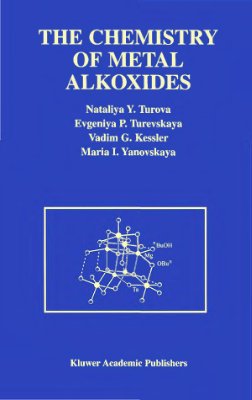New York, Boston, Gordrecht, London, Moscow: Kluwer Academic
Publishers, 2002. - 568 p.
The present book is devoted to the general questions of the chemistry of metal alkoxides — the synthetic routes to them (both laboratory and technology), physicochemical properties, structure, specific features of single groups of alkoxides, theoretical principles of their use for the preparation of simple and complex oxides by the sol-gel method, and major directions of the application of this method in the preparation of functional materials. Chapter 12 describes the derivatives of single elements of first throuth eighth Groups of the Periodic Table. The tables in this chapter contain the major data on the alkoxides, phenoxides, siloxides, derivatives of polyatomic alcohols, and phenols — their composition, structure, preparation techniques, and major physicochemical characteristics. Each table is accompainied by text that comments on it but is not a review in the classical sense of this word. These data allow this book to be used as a handbook permitting a quick and essentially complete acquaintance with the distinct compounds and the literature describing them.
The book is intended for chemists and technologists who specialize in the area of functional materials, and who apply the metal alkoxides in their practice. It also can be used as a textbook for students.
General synthetic approache
Physicochemical properties of alkoxides: regularities in the homologous series
Crystal and molecular structures of metal alkoxides
Oxoalkoxides
Specific features of physico-chemical behavior: «coordination polymerism»
Heteroleptic metal alkoxides containing carboxylato-, ?-diketonato, and aminoalkoxide ligands
Adducts and heterometallic alkoxides
Hydrolysis of metal alkoxides and synthesis of simple oxides by the sol-gel method
Synthesis of complex oxides from metal alkoxides
Hybrid organic-inorganic materials
The overview of metal alkoxtde derivatives along the groups of the periodic table
The present book is devoted to the general questions of the chemistry of metal alkoxides — the synthetic routes to them (both laboratory and technology), physicochemical properties, structure, specific features of single groups of alkoxides, theoretical principles of their use for the preparation of simple and complex oxides by the sol-gel method, and major directions of the application of this method in the preparation of functional materials. Chapter 12 describes the derivatives of single elements of first throuth eighth Groups of the Periodic Table. The tables in this chapter contain the major data on the alkoxides, phenoxides, siloxides, derivatives of polyatomic alcohols, and phenols — their composition, structure, preparation techniques, and major physicochemical characteristics. Each table is accompainied by text that comments on it but is not a review in the classical sense of this word. These data allow this book to be used as a handbook permitting a quick and essentially complete acquaintance with the distinct compounds and the literature describing them.
The book is intended for chemists and technologists who specialize in the area of functional materials, and who apply the metal alkoxides in their practice. It also can be used as a textbook for students.
General synthetic approache
Physicochemical properties of alkoxides: regularities in the homologous series
Crystal and molecular structures of metal alkoxides
Oxoalkoxides
Specific features of physico-chemical behavior: «coordination polymerism»
Heteroleptic metal alkoxides containing carboxylato-, ?-diketonato, and aminoalkoxide ligands
Adducts and heterometallic alkoxides
Hydrolysis of metal alkoxides and synthesis of simple oxides by the sol-gel method
Synthesis of complex oxides from metal alkoxides
Hybrid organic-inorganic materials
The overview of metal alkoxtde derivatives along the groups of the periodic table

